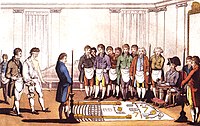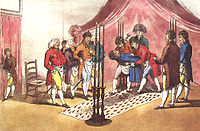User:JASpencer/Masonic ritual
Masonic ritual refers to the variety of scripted words and actions that have been spoken or performed by millions of people during the degree work in a Masonic Lodge. Each Masonic jurisdiction defines what is contained within its own ritual, and there are significant differences between the rituals of different jurisdictions.

Variety
[edit]
Much like a play, Masonic degrees are conducted from memory, following a script. However, every Masonic jurisdiction is free to standardize (or not standardize) a ritual for its own use. Therefore, a standard ritual for all does not exist.
However, there are similarities in conceptual content among jurisdictions. For example, all Masonic ritual for the first three degrees makes use of the architectural symbolism of the tools of the medieval operative masons (meaning those who were stonemasons by trade). Freemasons, however, consider themselves to be speculative masons (philosophical rather than actual building), and use symbolism and allegory to teach moral and ethical lessons such as the four cardinal virtues of Fortitude, Prudence, Temperance and Justice, and the principles of "Brotherly Love, Relief, and Truth" (commonly found in English language rituals), or "Liberty, Equality, Fraternity" (commonly found in French rituals).
Degrees
[edit]These moral lessons are presented to the candidate through the performance of the ritual. The use of allegory is a common thread. A candidate progresses through three degrees:[1] Entered Apprentice, Fellowcraft, and Master Mason (thus, allegorically, passing through the stages of a working stonemason's career). With each degree, the candidate gains knowledge and understanding of himself, his relationship with others and his relationship with the Supreme Being (as per his own interpretation). While the philosophical aspects of Freemasonry are intended to be interpreted by each individual Mason for himself, to encourage the candidate to reflect on their possible meanings they are sometimes discussed in Lodges of Instruction or Research, or in informal groups within a lodge.
Freemasons, and others, frequently publish — to varying degrees of competence and acceptance — studies on these philosophical aspects that are available to the public. Any mason may speculate on the symbols and purpose of Freemasonry, and indeed all masons are required to some extent to speculate on Masonic meaning as a condition of advancing through the degrees. There is no one accepted meaning and no one person "speaks" for the whole of Freemasonry.[2]
Masonic ritual in Literature
[edit]
There are a number of references to Masonic ritual in both literature and popular culture.
- In Tolstoy's War and Peace, Pierre Besouchoff joins the Freemasons, with his initiation into the Freemasons represented as being a turning point in his life[3]
- Rudyard Kipling's The Man Who Would Be King includes multiple references to and quotes from Masonic ritual. The protagonists of the story become "Kings of Kafiristan" through their knowledge of Masonic ritual.[4]
Exposés
[edit]There have been a number of purported exposés of Masonic ritual since Freemasonry was founded. Since Grand Lodges can and do change their rituals periodically, updating the language used, adding or omitting sections,[5] any exposé can only be valid for a particular jurisdiction at a particular time.
The first 'exposure' was by Samuel Prichard who printed Masonry Dissected in London in 1730.[6]
In the 1820s William Morgan wrote an exposé of the Masonic ritual used in New York State at that time. His disappearance before the book's publication set in train the events known as the "Morgan Affair" and led to the founding of the American Anti-Masonic party.
Other purported exposes of freemasonry have included Duncan's Masonic Ritual and Monitor,[7] David Bernard's Light on Masonry[8] and Jonathan Blanchard's Scotch Rite Masonry Illustrated.[9] Many of these have been described as inaccurate by Masonic authors such as Arturo de Hoyos,[10], who has written an introduction to and analysis of Bernard's work.[11]
The various exposés have had a mixed reception by Freemasons. The Masonic Service Association notes:
"Some exposés were written out of revenge; Morgan’s, for instance. Others may have been composed from a real desire to serve Freemasons by making it easy to learn ritual. Duncan boasts that nothing in his compilation will aid the uninitiated to gain entrance to a lodge. All, however, have been too generally regarded as harmful by those Masons to whom the secrecy of the institution is the be-all and end-all, to whom ritual is sacrosanct, and who believe any unobligated man who knows any of the ritualistic secrets is necessarily an enemy of the Fraternity and able to destroy it.
"Far from the truth are such impressions. With dozens of exposés printed; with hundreds to be bought for a few cents; with this cancer existing for more than two hundred years, would not Freemasonry have been long ago destroyed if these books were actually as harmful as so many supposed? Actually Freemasonry has grown from a handful of men in 1717 to five million in the civilized world, neither because of, or in spite of exposés..."[12]
References
[edit]- ^
United Grand Lodge of England (2005) [1815]. "Aims and Relationships of the Craft". Constitutions of the Antient Fraternity of Free and Accepted Masons (pdf). London: Freemason's Hall. pp. pp. x–xii. OCLC 18976592. Retrieved 2007-05-08.
{{cite book}}:|pages=has extra text (help) - ^ Hodapp, Christopher. Freemasons for Dummies, Wiley, 2006. p.15
- ^ Freemasonry in War and Peace Grand Lodge of British Columbia and the Yukon
- ^ Rudyard Kipling and Freemasonry, Paper by S P Thompson, reproduced on the website of the Grand Lodge of British Columbia and the Yukon
- ^ John J. Robinson, A Pilgrim's Path, M. Evans and Co., Inc. New York, p.129
- ^ Ritual, from the website of the Rosslyn Templars, accessed 11 October 2008
- ^ Duncan's Masonic Ritual and Monitor
- ^ [Light on Masonry http://books.google.co.uk/books?hl=en&id=QlIZAAAAYAAJ&dq=Light+on+Masonry&printsec=frontcover&source=web&ots=VAx34webFu&sig=Glib31ZAoH5KPf8gy5cyr_vLJO0&sa=X&oi=book_result&resnum=2&ct=result], by David Bernard, Google Books
- ^ [Scotch Rite Masonry Illustrated Part 1 the Complete Ritual of the Ancient and Accepted Scottish Rite http://books.google.co.uk/books?hl=en&id=OXLJC5da_BAC&dq=Scotch+Rite+Masonry+Illustrated&printsec=frontcover&source=web&ots=YE8U4niGWz&sig=GC76k2Fl9aAmJNQCHeUQJvgic74&sa=X&oi=book_result&resnum=9&ct=result], By John Blanchard, republished by Kessinger Publishing, 2002, hosted by Google Books
- ^ Is It True What They Say About Freemasonry?, by Art de Hoyos
- ^ de Hoyos, Arturo. Light on Masonry: The History and Rituals of America`s Most Important Exposure. Washington, DC: Scottish rite Research Society, 2008.
- ^ Those Terrible Exposures!, Short Talk Bulletin Series, Masonic Service Association, vol. XXX, No.7, July 1952, Washington, D.C., cited in Masonic exposés, an incomplete list from the website of the Grand Lodge of British Columbia and Yukon
